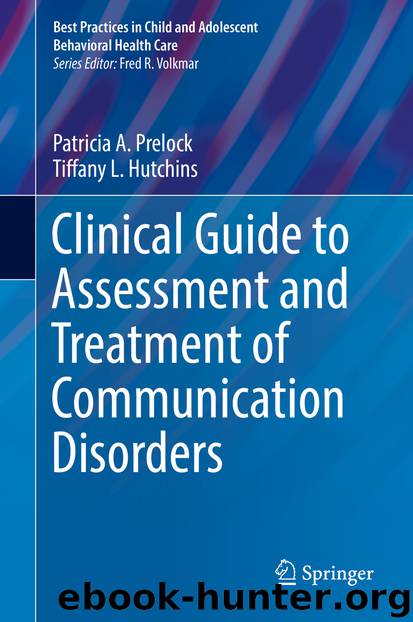Clinical Guide to Assessment and Treatment of Communication Disorders by Patricia A. Prelock & Tiffany L. Hutchins

Author:Patricia A. Prelock & Tiffany L. Hutchins
Language: eng
Format: epub
ISBN: 9783319932033
Publisher: Springer International Publishing
Phonological Error Patterns
Regardless of the cause, children with speech sound disorders often exhibit error patterns (often called phonological processes). The phonological processes that are common in typically developing children learning English are reviewed in Chap. 2. The processes of children with speech sound disorders vary based on the disorder. Those with dysarthria, for example, consistently produce imprecise, distorted consonants, such as lisped [s]. Due to their weak muscle tone, they also tend to demonstrate frication, an atypical error pattern in which stops (abrupt consonant sounds resulting from complete closure then release within the oral cavity, such as /p, t, k, b, d, g/) are substituted with fricatives (consonants with hissing sounds resulting from squeezing air in the oral cavity, such as [f, s, v, z] as well as “sh” and “th”).
Children with CAS tend to use more phonotactic (structural) processes than children with other speech sound disorders; this can result in omission, insertion, and/or mis-sequencing error patterns within words (e.g., attempting to say “clap” but producing “cap,” “clasp,” or “plack” instead). They also demonstrate vowel error patterns, which are rare in children who are typically developing. Children with cognitive-linguistic speech sound disorders often fail to learn the rules of their language, to mis-learn them, or to over-apply them. For example, an English-learning child with a speech sound disorder might not understand that /p/ and /b/ are different phonemes and might therefore use [b] exclusively at the beginnings of words (saying “buppy” for “puppy”), i.e., use the phonological process called “voicing,” and [p] at the end of the word (saying “mob” for “mop”), i.e., use the phonological process called “devoicing.”
In short, the fact that a pattern (or process) can be detected does not indicate the nature of the speech sound disorder. The specific type of pattern that is occurring is much more informative.
Download
This site does not store any files on its server. We only index and link to content provided by other sites. Please contact the content providers to delete copyright contents if any and email us, we'll remove relevant links or contents immediately.
Rewire Your Anxious Brain by Catherine M. Pittman(18299)
Talking to Strangers by Malcolm Gladwell(12871)
The Art of Thinking Clearly by Rolf Dobelli(9911)
Mindhunter: Inside the FBI's Elite Serial Crime Unit by John E. Douglas & Mark Olshaker(8699)
Becoming Supernatural by Dr. Joe Dispenza(7834)
Change Your Questions, Change Your Life by Marilee Adams(7374)
The Road Less Traveled by M. Scott Peck(7278)
Nudge - Improving Decisions about Health, Wealth, and Happiness by Thaler Sunstein(7242)
The Lost Art of Listening by Michael P. Nichols(7159)
Mastermind: How to Think Like Sherlock Holmes by Maria Konnikova(6936)
Enlightenment Now: The Case for Reason, Science, Humanism, and Progress by Steven Pinker(6871)
Win Bigly by Scott Adams(6827)
The Way of Zen by Alan W. Watts(6288)
Daring Greatly by Brene Brown(6225)
Big Magic: Creative Living Beyond Fear by Elizabeth Gilbert(5352)
Grit by Angela Duckworth(5296)
Men In Love by Nancy Friday(4964)
Ego Is the Enemy by Ryan Holiday(4957)
Altered Sensations by David Pantalony(4866)
